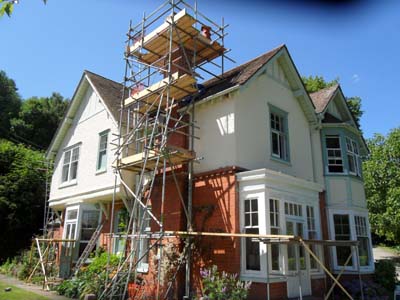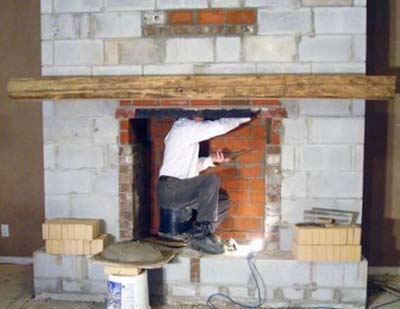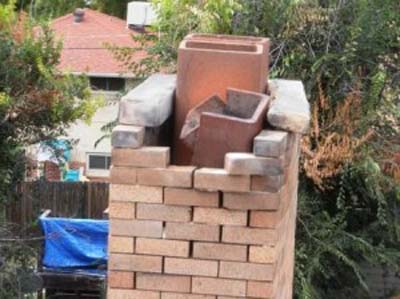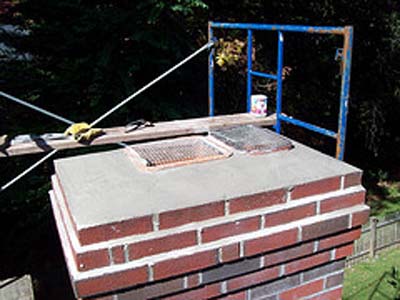Chimney and Firebox Rebuild
Chimney and Firebox Rebuild
- When a Professional Chimney Rebuild is Needed
-

- There are four major causes that lead to the chimney’s end of life and these include its original construction, frequency of usage, maintenance and the weather. If there is faulty initial construction, frequent usage over many years, or a lack of annual maintenance and cleanings, your chimney will start to degrade. This usually means the mortar is crumbling or bricks are cracking or both. Your chimney is the only part of the rooftop that is not protected by the roof. The brick is exposed to all types of weather in your area. Exposure to the elements such as an infiltration of water or an area that freezes and thaws often throughout the year will cause wear on your chimney. If it degrades the mortar completely, it will require a chimney rebuild.
- Rebuilding a Firebox
-

- If your fireplace has cracks or crumbling mortar when you run a trowel along the bricks, it needs to be replaced. If it is pre-fabricated, it is always necessary to adhere to the manufacturer’s pre-designated panels for the replacement of your firebox. If not, here are some steps that your professional chimney sweep will use to replace the firebox.
- 1)Masonry cement preparation: Follow the instructions that come with the cement package, and mix the appropriate combinations of sand, cement and other ingredients. Your sweep will want to have the existing mortar analyzed and matched so that the consistency of the new mortar matches the original.
- 2)Cleaning up the old stuff: Remove the mortar in the fire box using a hand rake and throw away this material. Mortar that is stuck to the bricks has to be loosened with the help of a crowbar and then released using the trowel. Only if the mortar is very stubbornly attached, is it a good idea to remove it with hard blows from a hammer. Once the mortar is removed, do not remove all bricks at once. First, take out the bricks at one section and replace them with the new set, one by one. Then, gradually move on to other sections and completely replace all the old bricks with new ones, also sealing them together using fresh mortar.
- 3) Combustible clearance: Your professional mason/sweep will make sure that the proper clearances to combustibles are done correctly for your type of firebox.
- 4) Brick pattern drawing: Use a trowel to draw the required patterns on the bricks. Apply cement with the refractories, on the panels, to give appropriate outlines.
- If your fireplace is pre-fabricated, then your sweep will look at the bottom panel of your firebox for manufacturer’s specifications. They will remove it from the panel and order the new model according to the old model’s specifications.
When a professional chimney sweep recommends that your chimney needs to be rebuilt, it is vulnerable to a chimney fire and beyond a simple repair of its existing materials. If the structural integrity of your chimney is no longer sound, such as this one pictured above, your professional sweep will recommend a rebuild.
- Rebuild a Masonry Chimney
- These are the most common chimney rebuilds that your professional sweep has done and here is an example of a "roofline and up" chimney rebuild. This chimney also needs a protective chimney cap installed after the rebuild is complete.
- • A Limited chimney rebuild: Only the top section of a chimney or if it is a small chimney, the entire thing is rebuilt to code. These are small jobs that usually require mortar and a few top bricks but do not require scaffolding. A new crown and cap will be placed on the top of your new chimney.
- • Roof line and up rebuilds: these include a lot more set up with scaffolding in many cases because there are a lot of parts coming off the roof and new ones going up. The deteriorated portion of the chimney is taken down to the flashing which is at the roofline. If the flashing is rusted and deteriorated, this part is removed to be redone also. Once the old portion of the existing chimney is torn down and disposed of, the rebuild to code can begin. A new crown and cap will be placed on the top of your new chimney.
- • Complete rebuild: In most of these cases the firebox, hearth, and smoke chamber stay intact, but the entire outer brick layer is torn down and rebuilt. The reason this would be required verses the roofline and up rebuild is because there is structural damage below the roofline such as a leaning chimney or severe mortar deterioration throughout.
- What kind of problems would create the need for a full chimney rebuild vs a repoint?
- The chimney is leaning to one side, there is no chimney liner because the chimney is so old and was built before this was required and the interior is coated in thick creosote, the mortar is completely crumbling, or there are large cracks in your bricks.
- Explain the process of repointing a chimney vs. rebuilding. What are the scenarios that would warrant a rebuild over repointing? What are the scenarios that would warrant a repoint done over a rebuild?
- Repointing is when the external portion of mortar is replaced or filled in on a masonry chimney. There is usually some structural integrity still left in the existing mortar, so it is safe to leave this portion intact and resurface the exterior of the brick joints. The rest of the old mortar between the joints can be removed easily in most cases because it is degraded and simply crumbles away. Unless you have very hard cement, in which case, you’ll need to use a chisel to remove it. When a repoint is done, the components of the existing mortar can be analyzed and matched. When the sweep has a mortar match, they can fill in the gaps between bricks and existing mortar to repoint the chimney. The gaps are usually about 3 inches thick but could be greater. Here is an example of a repointed chimney.
- If there is no structural integrity left in the existing mortar and it is crumbling or leaking water, a rebuild will be required. You will also need a complete rebuild if the chimney is leaning to one side, there is no chimney liner because the chimney is so old and was built before this was required and the interior is coated in thick creosote, or there are large cracks in your bricks.


